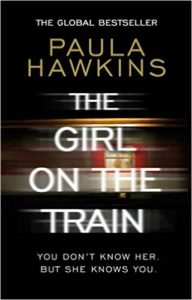Writing
Publishing The Girl on the Train
Some books come along and set the world on fire. The Girl on the Train by Paula Hawkins is one such rare book.
These books are publishing phenomenons, shooting up the charts and breaking all records, seemingly coming from nowhere. The Girl on the Train is everywhere! We wanted to know more about the publishing team behind The Girl on the Train so looked to Paula Hawkins’s Editor Sarah Adams and Publicist Alison Barrow to talk us through the process.
Sarah Adams, Publishing Director, Transworld Publishers
 What was your first reaction to reading The Girl on the Train?
What was your first reaction to reading The Girl on the Train?
I first experienced it as a partial script, and even though it wasn’t complete I still felt absolute exhilaration and confidence. Within a page I knew I was in expert hands with Paula, and by the end I was desperate for more. The synopsis Paula had provided was the cherry on top, as impressively written and compelling as the partial itself. I was hugely impressed.
What was it about the book that made you want to acquire it?
So much! The incredible premise is of course intoxicating and all too relatable (though I should clarify that I do not drink G&Ts on my way to work). I felt Paula was speaking directly to me as a commuter. Just what would I do if I saw something untoward out of the train window? Could I be certain I wouldn’t step out of my comfort zone, out of my everyday existence, and become involved?
But it is Paula’s fine, deft writing that brings that premise to life, and makes it shine. With her artful, arresting, unreliable narrative and her smart structure and timeline, she challenges the reader, testing our instincts and initial judgements, and turning us into detective. We may not like our protagonist, Rachel, but we are with her every step of the way, and we can’t help but care for her and, most importantly, fear for her.
Ultimately though, I knew this was a book that Transworld would publish brilliantly, and have a lot of fun with. Many of my colleagues raced through the partial within a day of my sending it to them, and everyone was bursting with ideas before we had even acquired the rights. We were ready to go!
The book has been compared to Rear Window and Gone Girl. Do you think these comparisons are accurate and why?

I love these comparisons, as they tap into some of the most intoxicating themes of the novel – the idea of the audience as voyeur and judge; the snap assumptions we make about people and domestic harmony; the temptation of a glance into someone else’s life as you pass by; and the ease with which ordinary people like you or I could step out of our perfectly normal lives and daily rituals, and into the awfulness of the unknown. Just think about the number of split second decisions we all make every day, and the ripples that might be created by one spontaneous move, or a single, terrible decision . . .
What do you look for in a manuscript?
I want to forget I’m reading a manuscript. Then I want to feel desperate to share it with my colleagues, and begin the conversation. It quickly becomes a team effort, and that is when the magic begins.
Alison Barrow, Director of Media Relations, Transworld Publishers
 When did you first realise that The Girl on the Train was something special?
When did you first realise that The Girl on the Train was something special?
The novel came to us already with the most irresistible hook created by Paula Hawkins and agent Lizzy Kremer – what really goes on in the houses you pass by on your train journey? – for a publicist that’s a gift. In the ever increasingly busy media landscape, PRs are are continuously looking for a seductive pitch to draw attention.
The book has been featured everywhere. What do you think makes it so popular?
I guess it’s that shared experience – so many of us have looked out of a train window and wondered… Paula’s writing is tight, and builds tension into a page-turning crescendo. Both these elements give The Girl on The Train maximum word of mouth buzz potential. Once people read it they want to press the novel into hands of others.
Is it possible to plan publicity for a book like this or does word of mouth take over?
Word of mouth doesn’t kick in without a huge amount of energy behind a campaign. It’s key to build anticipation stealthily over several months in advance of publication via all routes. We began building PR foundations a year before book release – securing selling blurbs from peer writers, sharing reading copies early with influential booksellers, book bloggers and ambassadors and then sharing this advance enthusiasm with mainstream media. A lot of planning helped build the foundations from the outset and then flexible strategic planning developed as the campaign evolved – we were consistently championing the book and didn’t stop (haven’t stopped!) since publication. The publicity fueled the early major sales for sure and now it has reached that magical tipping point – it’s become so widely bought and read that a good deal of spreading the word is organic – way beyond our initial promotion.
Social media is awash with The Girl on the Train. Were you expecting this reaction and how do you encourage all the readers out there to get involved?
I think all of us (publisher, author, agent) would confess that the reaction and sales of The Girl in the Train have far exceeded even our biggest ambitions. As a publisher we were very confident that we could deliver a wide reaching promotion – we said so from the outset. But none of us could have predicted the enormous international success of The Girl on The Train.
It’s been nothing short of thrilling to see how social media played (and continues to play) such a significant role. But here’s a thing. We have never (yet!) said no to people asking for a reading copy of the book. That underpins our confidence in Paula’s novel, and perhaps it has helped bring some of those on board who wouldn’t normally join the conversation.
A big thank you to Sarah and Alison for answering our questions! Not read The Girl on the Train yet? Check out an extract here.
2 Comments
Join the discussion
Please note: Moderation is enabled and may delay your comment being posted. There is no need to resubmit your comment. By posting a comment you are agreeing to the website Terms of Use.


Yes, I enjoyed it, it was fascinating to imagine what might be going on in the back gardens of London as the trains speeds by. And yet…. it didn’t altogether do it for me, I didn’t warm to the ending. But hey, it’s done so well and got people reading…. (film set in the States, it will certainly lose its London feel!)
I did find it a page turner….a great page turner…….but on the whole did not think it a good book for although the conflict was superbly developed, the solution, resolution was not. It was clumsy: and seemed to struggle in its effort to ‘get out’. Loved the flawed main characters but on the whole the story was too intense. It needed a little slack. Slack is very important.